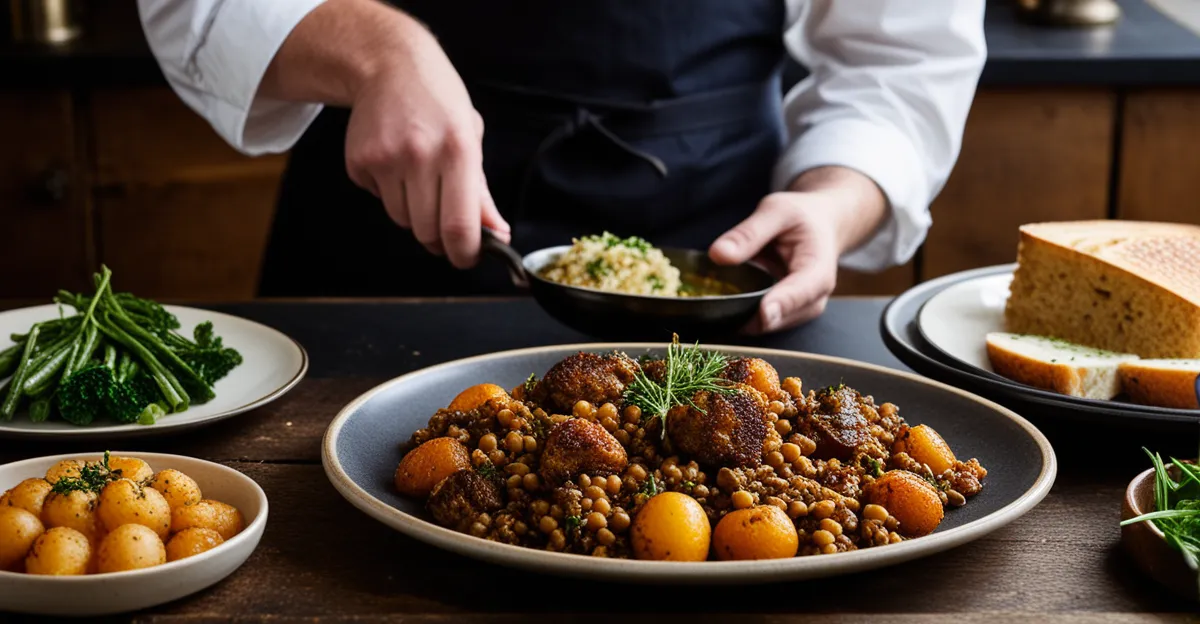Overview of Traditional UK Cuisine
Traditional UK cuisine is a rich tapestry woven from regional diversity and historical influences. Characteristically, this culinary heritage is defined by classic ingredients and techniques that have been passed down through generations. It’s a blend of longstanding practices and regional specialties that shape what is known today as traditional British cooking.
The importance of regional diversity cannot be overstated within UK food practices. England, Scotland, Wales, and Northern Ireland each bring unique flavors and dishes to the table, often influenced by the local climate, terrain, and historically available resources. These regions contribute distinct elements, creating a broad and varied cuisine that reflects the cultural fabric of the UK.
In parallel : How can you make a delicious spotted dick pudding from scratch?
Historically, the UK’s culinary traditions have been shaped by various influences, ranging from the travels and invasions of the Romans and Vikings to the extensive global connections of the British Empire. These interactions introduced new ingredients and cooking methods, enriching the local food landscape. As a result, traditional UK cuisine today is as much about the past as it is a testament to the fusion of diverse culinary practices that have marked British history.
Key Meats in Traditional UK Cuisine
Traditional UK cuisine places a significant emphasis on meats, with each region showcasing its own preferences and specialties. These traditional meat dishes often serve as the centerpiece of many meals. Their preparation techniques, often honed over centuries, reflect both the regional meats available and historical culinary influences.
In parallel : How do you prepare an authentic English breakfast?
Beef and Lamb
In the realm of traditional UK cuisine, beef holds a venerable position, especially in the form of British roast dinners. These hearty dishes often feature tender beef roasted to perfection, accompanied by Yorkshire puddings and a variety of vegetables. Lamb, conversely, is a staple in Welsh and Scottish dishes, prized for its distinct flavors. In Wales, lamb is often paired with mint sauce, which complements its rich taste, while Scottish lamb dishes are steeped in cultural traditions.
Pork and Game
Pork is another cornerstone of UK culinary tradition. It is pivotal in creating sausages and bacon, which are used in quintessential meals like the full English breakfast. Game meats such as venison, rabbit, and pheasant play a crucial role in rural UK cuisine. These meats are highly regarded for their robust flavors and are often served during hunting seasons, reflecting a long history of game hunting in British gastronomy.
Poultry
Poultry, particularly chicken, holds an esteemed place in British cooking due to its versatile nature, appearing in dishes ranging from simple casseroles to elaborate pies. Duck and turkey traditionally make appearances during seasonal celebrations. Turkey is synonymous with Christmas feasts across the UK, while duck is valued for its rich, succulent flavor, often featured in gourmet recipes for special occasions.
Essential Vegetables in Traditional UK Cuisine
Traditional UK cuisine places a strong emphasis on vegetables, particularly those that have been grown locally and are suitable for the seasonal climate of the region. From hearty root vegetables to robust brassicas, these elements are central to many classic British dishes, playing both a supporting and sometimes starring role.
Root Vegetables
Root vegetables, such as potatoes, carrots, and parsnips, are integral to the UK culinary landscape. Potatoes, in particular, are a staple food, with various preparations like mashed potatoes, roasted potatoes, and the quintessential British chips accompanying many meals. Carrots and parsnips frequently find their way into stews and roasts, lending their subtle sweetness to the overall flavour profile of these dishes.
Brassicas and Others
Brassicas, including cabbage, kale, and Brussels sprouts, offer traditional UK food a distinctive taste and texture. Cabbage is used extensively in both raw and cooked forms, providing a crunchy freshness or tender softness depending on its preparation. Brussels sprouts are especially popular during winter months, often served alongside roast dinners. The incorporation of seasonal and locally sourced vegetables ensures that dishes remain authentic to the UK’s culinary traditions, celebrating both the fresh produce and the changing seasons.
Dairy Products Integral to Traditional UK Cuisine
Traditional UK cuisine showcases a rich selection of dairy products, an integral element to the country’s culinary heritage. Dairy not only adds essential nutrients but also enhances the flavours of various dishes. The UK is celebrated for its diverse cheese varieties and milk products, owing partly to its conducive dairy farming climate.
Cheeses
The UK boasts a wide array of regional cheeses, each with its unique characteristics. Cheddar is arguably the most famous, originating from Somerset, and is known for its sharp, creamy taste. Stilton, on the other hand, is the “king of English cheeses,” recognized for its rich and tangy blue veins. These cheeses play significant roles in traditional dishes, contributing both flavour and texture.
Milk and Cream
Milk and cream are staples in a multitude of English recipes. Milk is fundamental in preparing traditional puddings and sauces, providing a creamy base that balances the flavours of sweet and savoury dishes alike. Meanwhile, clotted cream is a culinary delight, especially when served with scones—a beloved pairing in the iconic British cream tea. This thick, luscious cream elevates desserts and is a testament to the UK’s enthusiastic embrace of dairy products in traditional meals.
Herbs and Spices in UK Cooking
Herbs and spices have long played a pivotal role in traditional UK cuisine, enhancing the flavor profile of various regional dishes. These elements are central to the country’s culinary identity, lending aromatic depth and distinction to British recipes.
Commonly Used Herbs
In the realm of UK cuisine, herbs like parsley, thyme, and rosemary are prevalent. Parsley is often used both as a garnish and a fundamental ingredient, providing a fresh note to broths and casseroles. Thyme, with its subtle lemon flavor, complements meats and stews, while rosemary adds a distinctive aroma to roasted dishes. These herbs not only enhance taste but also underscore the regional diversity in UK food practices by reflecting local tastes and traditional preparations.
Spices and Seasoning
Spices such as black pepper and mustard are integral to the UK’s flavor palette. Black pepper is a ubiquitous seasoning that enriches everything from traditional pies to contemporary cuisine. Mustard, known for its pungent heat, is a staple in both the English pantry and in homemade condiments like mustard sauce. Additionally, traditional spice blends such as curry powders have gained ground over the years, indicative of historical influences and global connections, enriching the culinary heritage of the UK. These components are essential not only for their flavors but also for their ability to unify various ingredients into cohesive and expressive dishes.
Iconic Dishes Utilizing Key Ingredients
Traditional UK dishes are renowned for their classic recipes and profound culinary significance, showcasing the rich tapestry of British food culture. This section delves into some of the most iconic dishes, emphasizing the key ingredients that define them.
British Roast Dinner
A quintessential part of British gastronomy, the British roast dinner is a celebration of comfort and heritage. Typically, this dish features roasted meats—often beef—accompanied by Yorkshire puddings, roasted potatoes, and a medley of seasonal vegetables. The choice of meats and vegetables often reflects regional preferences, with variations like lamb in Welsh and pork in some English counties. The inclusion of gravy, sometimes flavored with herbs like thyme, ties the meal together, highlighting the British knack for combining humble ingredients into a sumptuous feast.
Shepherd’s Pie and Cottage Pie
Shepherd’s Pie and Cottage Pie are beloved staples, each with a unique combination of ingredients reflecting their rustic origins. Shepherd’s Pie traditionally uses lamb, while Cottage Pie utilizes beef; both are layered with mashed potatoes, enhancing their heartiness. These dishes embody an evolutionary culinary heritage, originating from the resourceful use of leftovers. Their adaptability allows for regional twists, such as incorporating local herbs or vegetables, maintaining their status as comfort food favorites.
Fish and Chips
No discussion of traditional UK cuisine would be complete without the iconic Fish and Chips. This dish marries battered fish, typically cod or haddock, with crispy chips, often served with a side of mushy peas, tartar sauce, and a sprinkle of salt and vinegar. Its cultural relevance extends beyond the dining table, symbolizing British coastal communities and the nation’s seafaring history. Regional variations might feature different types of fish or accompaniments, but the core essence remains a pillar of British fare.






